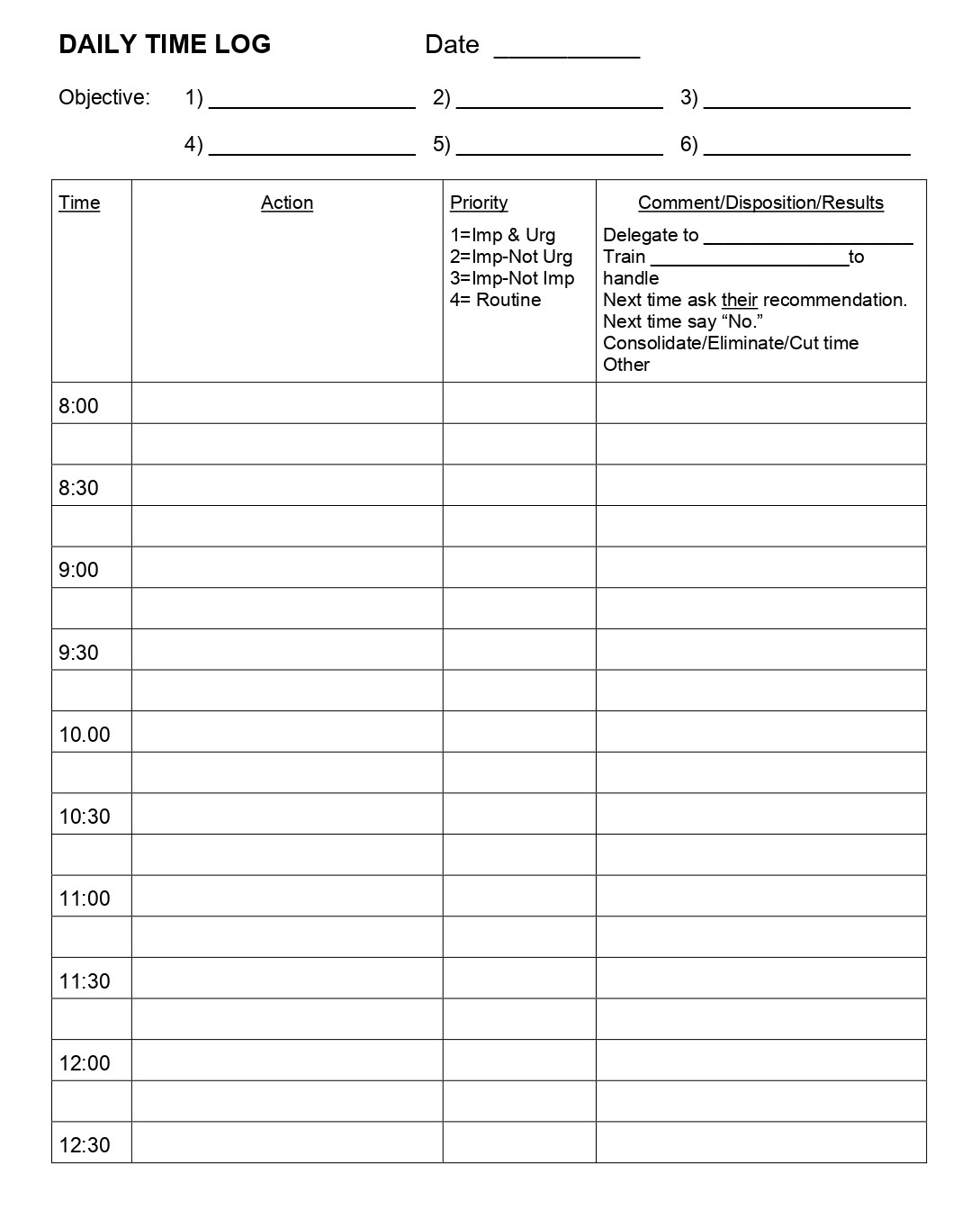Duration – At Least One Week
The recommended length of time you should keep a time log is a minimum of one week. Even though you may feel some resistance or uncertainty, it is not a waste of time. Your probable initial conclusion—the week was a “most untypical period” is universal. There is no “typical” period.
Instructions for Completing the Daily Time Log
1. Enter the date and list your daily objectives. These should be listed in order of priority. Wherever possible, list objectives in terms of results, not activity (examples: “Gain consensus on caseload distribution” or Hold meeting on caseload”). Keep four criteria or objectives in mind while setting them:
a) In measurable terms (I will know whether I achieved them)
b) Achievable (to avoid built-in frustration)
c) Demanding (to insure sense of accomplishment), and
d) Flexible (in case circumstances over which I have no control change).
2. Establish deadlines for each objective. Determine by what time of the day you will have completed each objective. This serves as a reminder throughout the day and provides a major force to overcome procrastination, indecision, and distractions.
3. Record all significant actions in terms of results during each 15-minute period. Do not wait until noon or the end of the day, or a major benefit—tracking interruptions—will be lost. Be detailed in your recording. Examples: 10:00 boss dropped in to socialize. 10:20 PR phoned for forecast on x case.
4. Prioritize each action. In the second column, note each priority as indicated. Think of “important” as suggesting only long-term consequences and of “urgent” as suggesting only immediate consequences. Examples: Caught up on mail
(4=routine). Revised airline reservations for boss’ trip (3=urgent). Completed proposed revision to organization chart (2=important, not urgent). Meeting with major client to save case (1=urgent & important). This column should provide at a glance an overall picture of effectiveness of time utilization.
5. Comment on each action. Include reference to its disposition, its possible delegation (identify and set deadline for completing delegation, or other steps to improve time utilization. As with Step 3, this step should be taken as the action is recorded. While perspective may improve with time, memory lapse offsets this supposed benefit. Make your analysis immediately. You can always change it.
6. Questions to be answered immediately following completion of time log:
A. Did setting daily objectives and deadline improve your effectiveness?
1) Why? Why not?
2) Were objectives and deadlines demanding yet realistic? If not, why? (overconfidence, attempting too much, unrealistic time estimates, crisis distraction-prone?)
3) Which of your daily objectives contributed directly to your long-range objectives?
4) Which objectives could have been delegated?
B. What time did you start on your No. 1 objective?
1) Could you have started sooner?
2) Did anything distract you from completing it? What? Why? Could you have avoided the distraction?
3) Did you recover immediately—and return at once to your task?
C. To what extent did you achieve each objective?
Objective % Accomplished Reason for Noncompletion
1. ________________________ ____________________ ____________________________________
2. ________________________ ____________________ ____________________________________
3. ________________________ ____________________ ____________________________________
4. ________________________ ____________________ ____________________________________
5. ________________________ ____________________ ____________________________________
6. ________________________ ____________________ ____________________________________
D. What was your longest period of totally uninterrupted time (excluding meetings and lunch)?
1) Which period of the day was most productive? Why?
2) Which was least productive? Why?
3) Is this likely a normal pattern? Yes _____ No _____
4) If yes, how could you program or pace your activities to take advantage of it?
5) How could you make other periods of the day just as productive?
E. Who/What was your most frequent interruption?
1) What are the causes?
2) How can these be controlled, minimized, or eliminated?
F. In order of importance, list all types of interruptions with which you must contend, e.g., telephone, drop-in visitors, unscheduled meetings, unexpected crises, mail, self-interruptions, visual distractions, noise etc. For each of the first three, list two or three steps you could take to control them.

G. List the 5 most time-consuming activities which could have been handled by someone else or not done at all. How will you handle these the next time?
Actions How Will Handle Next Time?
1. ______________________________________ ________________________________________
2. ______________________________________ ________________________________________
3. ______________________________________ ________________________________________
4. ______________________________________ ________________________________________
5. ______________________________________ ________________________________________
H. Did you tend to record “activities” or “results”?
I. Did a self-correcting tendency appear as you recorded your actions?
J. Of the solutions suggested above, which 3 will you implement immediately?
_________________________________________________________________
_________________________________________________________________
_________________________________________________________________
TIME LOG ANALYSIS SHEET
1. Do you set daily goals/activities?
2. What major categories or activities do you engage in?
3. Did you have a number 1 priority goal?
a. What time did you start this goal?
b. Could you have started sooner?
4. What was the longest uninterrupted period of your day?
5. What period of the day were you most productive? Least productive?
6. What was the most common source of interruption? What were the causes of these interruptions?
7. On what items did you spend too much time? Too little time?
8. What items could someone else have handled?
9. Did you record activities or results?
10. On which items do you think you could achieve your most significant time savings?


